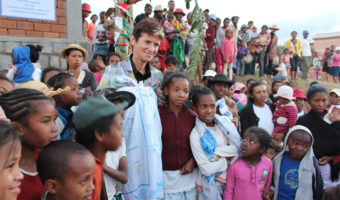Financing the early childhood workforce – frontline health, education and social welfare workers and those who train and supervise them – is a critical but neglected policy issue. Based on a recent review of country experiences, in this article we propose three principles: making a stronger investment case to policymakers; developing budgets that reflect actual workforce needs; and advocating for legislation that institutionalises workforce development programmes.
The issue is critical because early childhood provision is expanding rapidly in low- and middle-income countries: for example, global pre-primary rates increased from 32% to 47% between 2000 and 2015 (UNESCO, 2018). Yet service quality is not always improving. Workforce calibre is not the only determinant of quality, but it is key (International Labour Organization (ILO), 2012; UNESCO, 2015). Recent research reviews consistently find that well-trained educators improve the quality of early childhood care and education programmes in developing countries (Engle et al., 2011; Behrman et al., 2013; Rao et al., 2014). From Bangladesh to China to Costa Rica, there is evidence of a positive relationship between better-educated and trained personnel and both programme quality and children’s outcomes (Rao et al., 2014; Neuman et al., 2015).
Three challenges to scaling-up a quality workforce
Building and supporting a cadre of competent early childhood personnel is difficult, for three main reasons.
- The sheer pace at which early childhood programmes are expanding creates a greater need to identify, train, supervise, and monitor new staff – a labour- intensive process – while also putting more strain on already-stretched existing personnel.
- There is undersupply of potential workers (UNESCO, 2016; The Lancet, 2018). As a result, in many countries, paraprofessionals and volunteers comprise a significant portion of the workforce (Araujo et al., 2013). While these are important, more full-time, trained professionals are needed to improve and sustain child development and learning opportunities.
- Qualified personnel tend to cluster in urban areas; it is challenging to attract them to work in rural areas – but necessary in order to close geographic equity gaps and deliver services at national scale (Mitter and Putcha, 2018).
These three challenges help explain why the workforce in many countries cannot meet access and quality objectives. For example, UNESCO has found that fewer than half of pre-primary teachers were trained to national standards in one-quarter of the 80 low- and middle-income countries with available data (Neuman et al., 2015). This message was reinforced during a comprehensive set of key informant interviews with policymakers and practitioners in 15 countries, conducted as part of the Early Childhood Workforce Initiative (2019). For example, policymakers pointed to an array of recruitment and retention issues, and limited efforts to address them (Early Childhood Workforce Initiative, 2019).
The relationship between financing and the workforce
‘Greater financing can improve access to pre-service training and ongoing professional development opportunities.’
Additional money is not a panacea, but lack of investment undergirds all these multifaceted challenges. The early childhood workforce in low- and middle- income countries is characterised by low pay, low status and poor working conditions (ILO, 2012; Pearson et al., 2017). Low pay, relative to other sectors, makes it harder to attract and retain qualified personnel: fewer qualified candidates apply and turnover rates tend to be higher, undermining the stable relationships children need for their healthy development (OECD, 2012). Greater financing can improve access to pre-service training and ongoing professional development opportunities, which are urgently needed to ensure quality and consistency of services. It can also provide incentives for individuals to work in rural areas (Mitter and Putcha, 2018).
On average, low-income countries allocate only 2.9% of total education spending to pre-primary education – well short of the recommended benchmark of 10%. The limited data available suggest that there is similar underinvestment in more comprehensive early childhood development services (Zubairi and Rose, 2017).
Current underinvestment may reflect perceptions among governments, programme managers, and even parents that working with young children is little more than babysitting, rather than a profession that requires skills, competences and ongoing support. Such perceptions may also help to explain why available funding is often used to expand access to services rather than improve quality – hiring new staff and opening new centres, rather than training and supporting existing personnel.
Ghana, for example, has rapidly expanded pre-primary education over the past decade – but despite government efforts to support workforce development, about a quarter of kindergarten teachers remained untrained (Putcha, 2019a).
In many countries, parents pay for child care and pre-primary education, so investments in pay, training and working conditions may lead to higher fees unless offset by government subsidies. To avoid burdening lower-income families, workforce development efforts should therefore be situated within a broader financing strategy. Recognising that parent fees alone cannot cover the full cost of quality provision, the Education Commission has called for countries to provide two years of free pre-primary education (International Commission on Financing Global Education Opportunity, 2016).
Principles for sustainable financing of the workforce
Fortunately, a number of countries have successfully secured – and rationally allocated – funds to recruit and retain a strong early childhood workforce. From a recent review of country experiences, conducted under the Early Childhood Workforce Initiative, three principles emerge.
1 Make a stronger investment case to policymakers for prioritising workforce development
The returns on investing in early childhood development are well established (Garcia et al., 2016). As Richter et al. note (2018), providing a minimum package of early childhood development services would require 2.7% of GDP (with aid) for low-income countries, 1.2% for lower middle-income countries and 0.8% for upper middle-income countries. Their call for a minimum global benchmark of 1% of GDP represents an important call to action that holds the potential to enhance the quality of services in many countries.
‘A significant proportion of new financing needs to be directed toward workforce development.’
A significant proportion of new financing needs to be directed toward workforce development. For that reason, the ILO has proposed (2012) that governments invest at least 1% of the teacher payroll per year to support in-service training of teachers across all levels, including pre-primary education.
Encouragingly, advocates increasingly have more data, evidence and country examples upon which to make the case for more financing, thanks to analyses coming from initiatives such as the Early Childhood Workforce Initiative, the Education Workforce Initiative, and the Global Social Service Workforce Alliance. And there have been recent examples of countries meaningfully increasing investment. For example, in Ecuador, government spending on early childhood development more than doubled between 2008 and 2012, which significantly improved pre- and in-training options available to the workforce, among other achievements (Bonsu, 2019).
One effective strategy for making the case to policymakers is to cultivate and leverage influential individuals to act as ‘champions’. This tactic was employed with some success by civil society actors and sub-national government representatives in the Philippines, resulting in more funding for training of personnel in childcare centres (Putcha, 2019c).
Another area with potential is encouraging established trade unions to do more to organise early childhood workers. Unions and professional organisations have effectively mobilised resources for workforce development in the education of older children, but early childhood personnel in developing countries have been less likely to benefit from workers’ rights movements, given their wider diversity and relatively low status (Shaeffer, 2015).
2 Develop budgets that reflect actual workforce needs to ensure quality and equity, and create systems for ensuring budgets are spent appropriately
For the early childhood workforce to be sustainability financed, budgets must reflect their actual needs. This does not always happen, owing to a lack of administrative planning capacity and the difficulty in costing dynamic, complex programmes. For example, in India, scaling of the Integrated Child Development programme has been hampered by budget estimates being calculated based on the number of existing beneficiaries, rather than using census data for children in the target age group (Putcha et al., 2016).
While salaries typically represent the largest share of workforce expenses (Josephson et al., 2017; Gustafsson-Wright and Boggild-Jones, 2018), a range of other costs must be considered, including in-service and pre-service training, supervision, mentoring and materials. Underbudgeting can undermine quality through staff shortages, high turnover, and undertrained personnel. It also forces programme managers and policymakers to find savings, in ways which often lead to inequities in access – for example, allocating insufficient funding to lower-density, more dispersed populations.
Tools such as the Standardized Early Childhood Development Costing Tool, developed by the Brookings Institution, can help improve the precision and comparability of costing efforts within and across countries (Gustafsson-Wright et al., 2017).
Accountability systems are needed to make sure that when sufficient resources are allocated to workforce development, they are not diverted to other purposes. A good example comes from Chile: early childhood services receiving funding under Chile Crece Contigo – an intersectoral, multicomponent child development policy – are required to provide monthly reports which document how money received has been spent (Putcha et al., 2016).
3 Advocate for legislation that institutionalises workforce development programmes
‘One strategy for ensuring sustainability of financing is to institutionalise programmes in legislation.’
Even effective programmes run the risk of not having sufficient funding to continue operations and sustain quality improvement efforts over time – especially when they rely on external funding. One strategy for ensuring sustainability of financing is to institutionalise programmes in legislation. Enacting policies that formally recognise successful pilots or programmes increases the chance that they will be granted a recurring line item in national (or in more decentralised contexts, sub-national) budgets.
For example, since 2014, community health volunteers in Siaya County, Kenya, have conducted home visits where they deliver messages on responsive caregiving and monitor child development as part of a broader strategy of implementing the Care for Child Development package. County officials are now developing a Community Health Services Bill which would allocate budgetary resources for the stipends of these personnel, as well as health insurance (Nurturing Care for Early Childhood Development, online; Putcha, 2019b).
Such efforts to institutionalise workforce development programming into policy can have long-lasting impact, helping them to endure when new political leaders are elected. As beneficiaries grow to expect such services, it becomes more politically unpopular to reduce their funding.
References can be found in the PDF version of the article.



